Why the Salkantay Trek is the best way to see Machu Picchu
Wondering if you should hike the Inca Trail or Salkantay Trek to Machu Picchu? Here’s what we experienced on the 5 day Salkantay Trek.
Day 1 – Hike from Challacancha to Soraypampa (10km)
At 3:30am we wake up at our hostel in Cusco and wait outside for the van, which we’re told will turn up between 4-4:30am.
It’s a two hour drive to Mollepata for breakfast, where we also pay for entry to Salkantay region.
For breakfast we fill up on omelettes, juice, bread and coffee, then hop back in the van for a further 45 minute drive to Challacancha, where we start the trek.
We’ll be trekking approximately 8km on day one, starting at Challacancha (3,661m), sleeping at Soraypampa (3,868m), and taking a side trip up to the beautiful Humantay Lake (4,221m).
Our guide, Yuri, gives us a quick briefing before we began hiking just after 9am. “Throughout the trek we will pass through four ecological regions. In all of Peru there are 8.” I get the feeling this hike is going to be diverse. “Here, we will find unique plants along the way due different altitudes.”
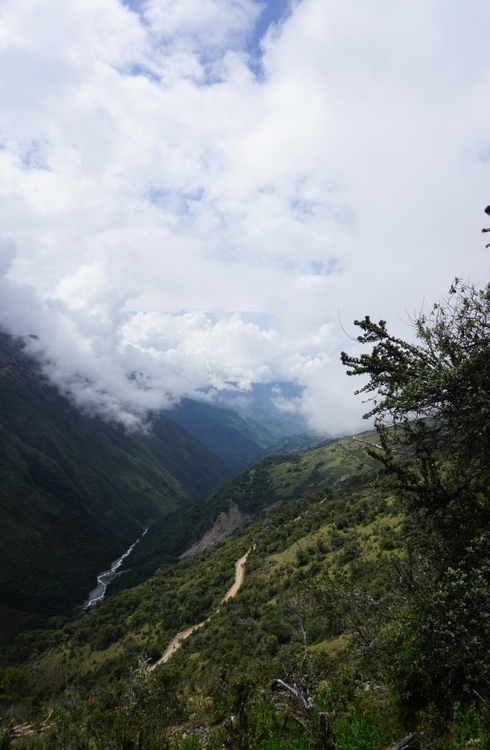
Yuri refers to Machu Picchu as the high jungle – or cloud forest – sitting at 2,400m altitude. He tells us Machu Picchu National Park is larger than 30,000 hectares, and that if on day five we choose to hike to Huayna Picchu we could potentially see Salkantay mountain from the top.
We stop multiple times to learn about plants along the way. Yuri plucks off a leaf and smells it. “Depending on the latitude, muña leaves look different. They make good tea, helpful for your digestive system.”
He points to a purple flower, “Lupinus is poisonous. The white seeds are sold at markets, and they’re really good for your bones as they are full of calcium. Back in the Inca period, they ate the Lupino seeds.”
We arrive at Soraypampa (3,880m) at 11:30am. We’re assigned a sky dome, and pop our things inside before we head to the communal eating area for lunch.
First course is a salad of beans, halloumi and carrots.
Second course is quinoa soup.
Third course is two plates of rice with cucumber and tomatoes cut into fancy shapes, two plates of mashed pumpkin soup with halloumi, a plate of trout wrapped in cheese, a plate of zucchini with tomato sauce, a plate of plain beans, carrots and cauliflower and a plate of roasted potatoes.
After the banquet we’re each given a cup of coca tea to help with the altitude and go back to our domes for a short rest.
At 2:30pm we meet outside the sky domes and start the hike up to Humantay Lake which sits at 4,200m. We’re told it should take approximately 1.5hrs, but we get there in just over an hour.
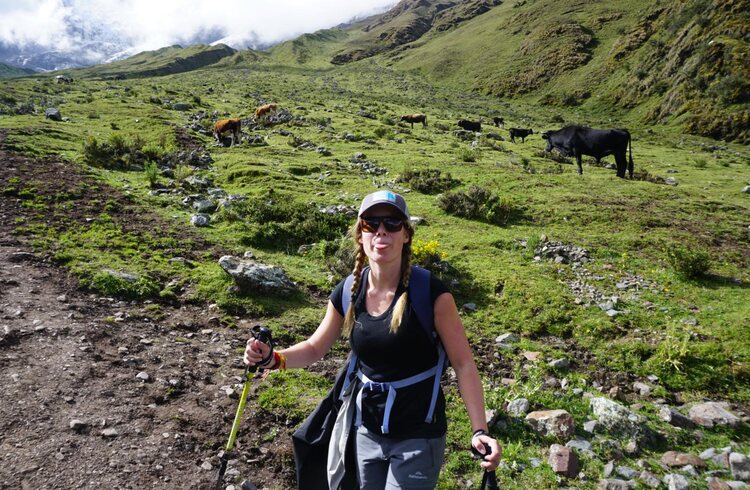
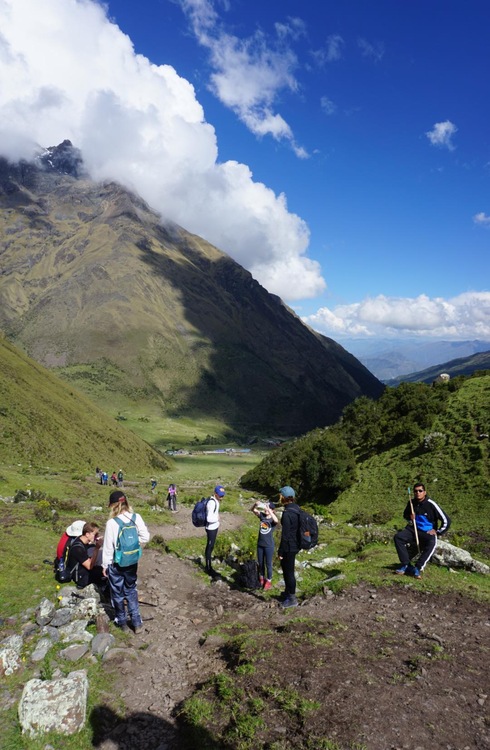
The name Humantay means “head of the gods”, and the summit is 5,800m. This is a sacred mountain for the local people, who make offerings to the mountains in the form of “apachetas” – piles of rocks.
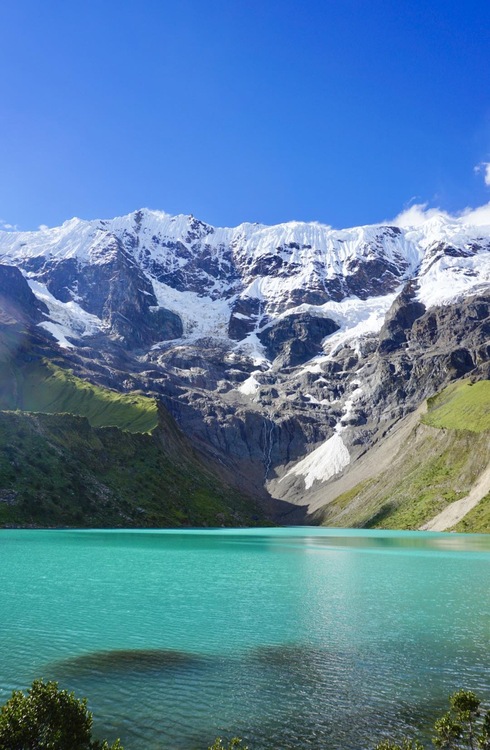
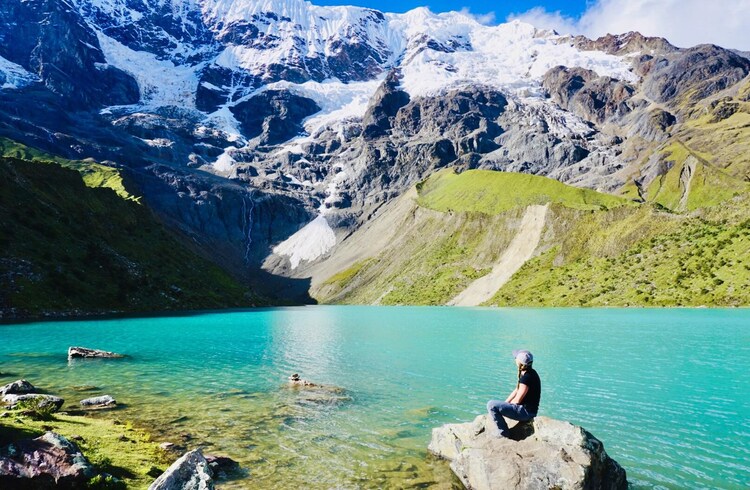
Yuri tells us only one person has successfully summited Humantay mountain due to difficult access and tough climbing conditions. I sit and wonder what it’s like up there from my perch on a rock.
We spend an hour at Humantay lake enjoying the views and begin the descent at 4:20pm.
At happy hour we’re served popcorn, tea, hot chocolate, cookies and deep fried crispy wontons filled with either cheese or banana.
As the sun set behind the mountain we could feel the temperature drop dramatically and put on warm clothes ahead of dinner.
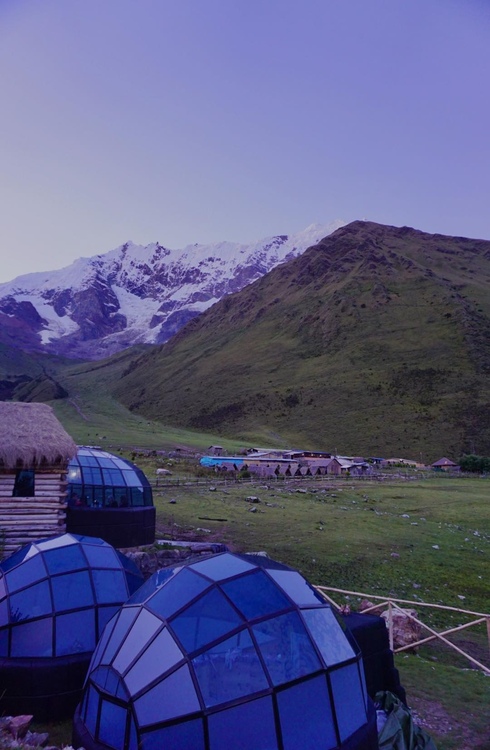
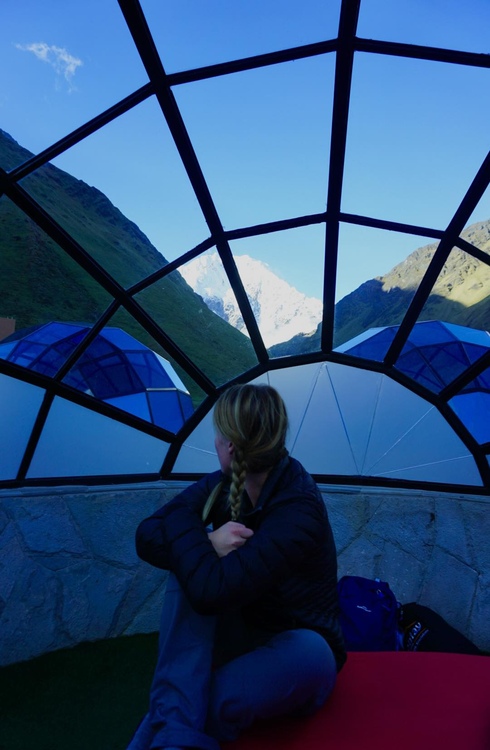
For dinner we eat corn soup, pizza, potatoes, pasta, fried chicken and veggies. For desert we’re served flaming bananas.
At 8pm we hop into bed thinking we’ll be able to see the stars twinkling through the windows above, but it’s fogged up from the heat inside.
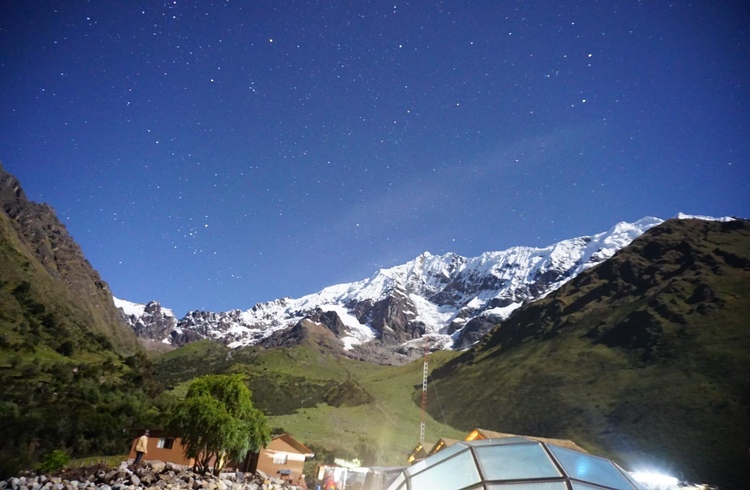
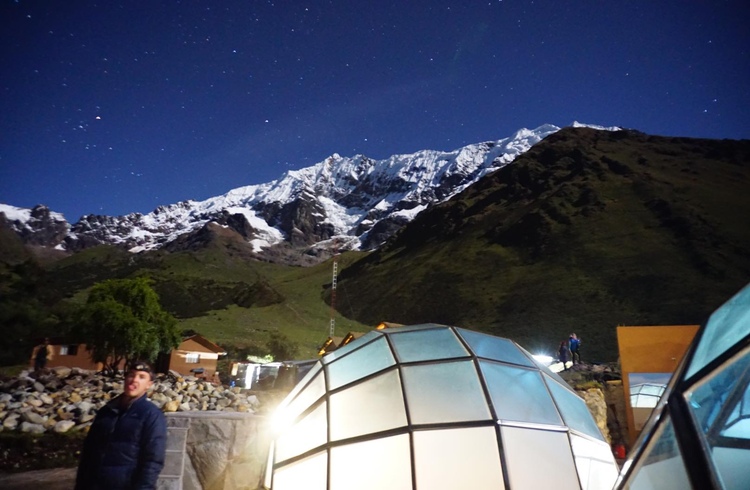
Day 2 – Soraypampa to Chaullay (23km)
At 4:30am Yuri makes the wake up call with a knock on each of our sky domes. Today we’ll be hiking to Salkantay Pass.
For breakfast we eat eggs, bread, hot chocolate, pancakes and fried bananas – a hearty meal for a long day of hiking ahead.
The path up to Salkantay Pass winds past vegetation and we cross some dodgy wooden bridges. I fail to follow in Yuri’s footsteps and step in a deceivingly deep puddle. It’s a good reminder to keep an eye on where I’m walking.
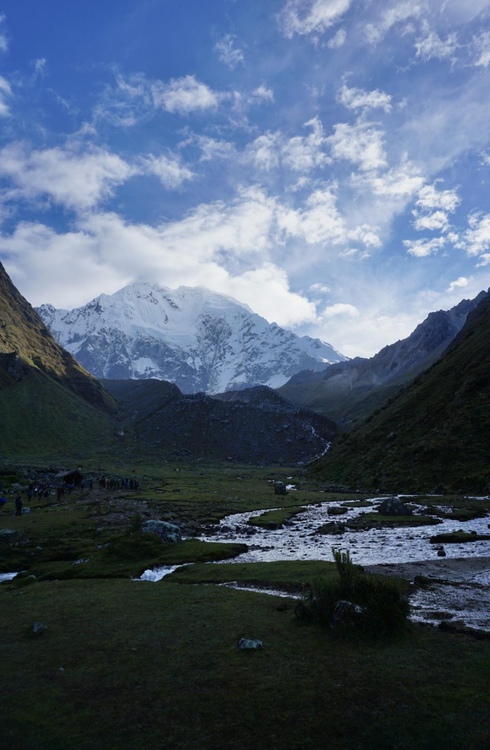
At 7:20am we reach Salkantaypampa (4,140m) where we find a little hut with a toilet inside that has a tarpaulin for a door. A guy we befriended in our tour group happily goes inside, pulls down his pants and doesn’t think to flick the tarpaulin door down. This becomes the joke of the day, making it harder for us to ascend as we wheeze with laughter to the top.
The sun begins to rise over the mountains at 7:30am and we simultaneously feel the need to strip off a few layers.
After a difficult hike to the top, we reach Salkantay Pass (4,638m) at 9:40am. It’s cloudy and cold up here, and we happily accept the hamburgers Yuri hands out as a celebratory second breakfast.
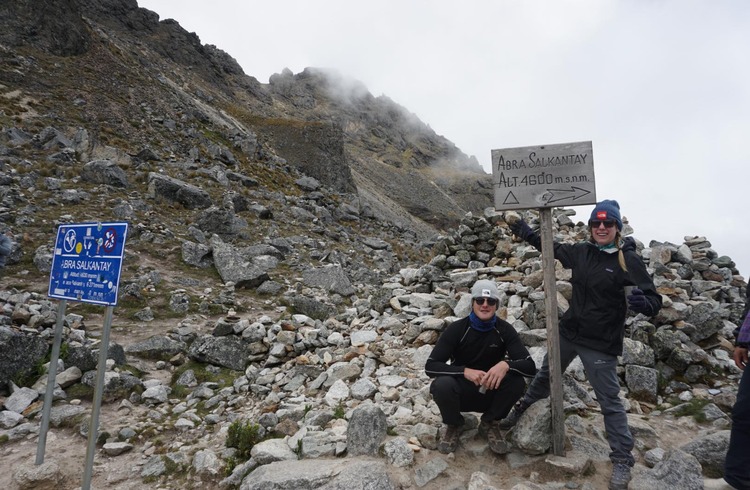
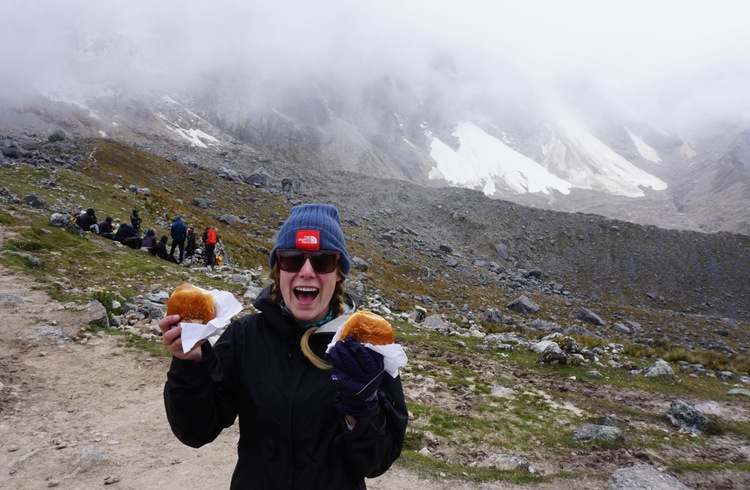
Once we finish eating, we begin the descent to Wayramachai (3,730m) where we’ll be having lunch.
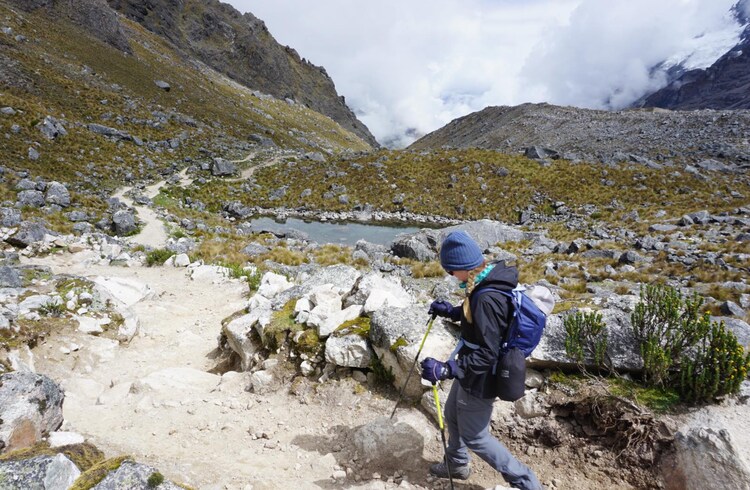
At 12pm heavy rain begins to fall, mere hours after we’re told the rainy season had ended four days ago.
When we reach Wayramachai at 12:30pm we’re served potatoes, rice, pumpkin, soup, and a tuna roll inside a makeshift tent. It’s wet and soggy outside so we enjoy the rest and stay dry while we can.
At 2pm we begin hiking again while all wearing ponchos. This time, we’re descending into the forest and we’re quickly reminded why it’s important to wear insect repellant. The mosquitoes are coming at us in droves.
Just before 5pm we make it to our final destination for the day, Chaullay (2,890m). All up, we hiked 23km on day two.
For dinner, we eat soup, potatoes, chicken, passionfruit, noodles, and have a pineapple jelly dish for desert. We’re all asleep by 8pm.
Note: day two’s accommodation is different now, you will sleep in mountain view lodges. Back in 2018 when we did the Salkantay Trek they were being built so we stayed in a different type of accommodation.
Day 3 – Chaullay to Lucmabamba (16km)
At 5am Yuri makes the wake up call after a solid sleep. At 5:40am we’re served fried plantains, bread, two types of cake, coffee, tea, and a quinoa drink for breakfast.
At 6:40am we begin day three of hiking, and the scenery is different again today as we’re walking through an enormous canyon. A waterfall crosses part of the path, and we carefully follow Yuri’s footsteps across rocks, careful not to wet our hiking boots or fall in the water.
Yuri points to a huge landslide that happened just the week before.
As we walk, he begins to tell us about a Swedish expedition who conquered Salkantay (6,200m) in 1952. “This is a very sacred mountain. Climbers must offer coca leaves to pachamama – asking mother earth for safety and permission to climb.” Many expeditions have tried and failed over the years, but more success has been seen in the last few years where some expeditions have reached the top with Sky High Andes expeditions. It’s a super technical climb.
He tells us there was an Argentinian expedition where 13 climbers died when an avalanche swept down the mountain in 1993. Only two people survived. I can’t find any evidence of this incident through research – so if anyone knows if this is true, please confirm.
At 12pm we reach Sahuayaco (2,080m) where we stop for organic coffee and learn about the coffee making process. Arabica trees produce 3kgs of coffee per year, from April to October. When the beans go red they’re ready to pick. Out of season they are just white flowers.
We pick the beans ourselves and grind them by turning a handle attached to a machine, then roast the beans over a fire. The wood for the fire is also from the trees that shadow these particular coffee plants.
At 12:30pm, we hop into a van to start the drive to our accommodation which is 10 minutes away. We arrive at Lucambamba (2,000m) where we are each assigned a jungle dome and drop off our things. For lunch we eat a plate of guacamole with chips, soup, rice, chicken, pork, vegetables, and juice.
On day three we have hiked a total of 16km, and now it’s time to relax in the hot springs.
Just after 2pm we drive from Lucambamba to the hot springs in Santa Teresa, which are about 40 minutes away. These large hot pools are nestled in the valley and we enjoy the view as we relax in the warm water.
At 6pm we get back to Lucambamba for happy hour. For dinner we’re served chicken, beef, rice, vegetables, and a pineapple and chocolate dish for dessert. We’re in our jungle domes for bed by 8:30pm.
Day 4 – Lucambamba to Aguas Calientes (22km)
On day four we wake at 4:45am to Yuri knocking gently on our doors. Breakfast is served at 5:30am. We eat bread, cereal, fruit, apple pie, and juice. That’s right, apple pie for breakfast.
At 6:20am we start hiking and the first stretch is 800m uphill. We’re told once we reach the top we’ll be descending 1,000m – all before lunch. After the steep descent we’ll be walking along a flat path beside the train tracks to Aguas Calientes.
We’re a few kilometres from Lucambamba walking along the old Inca trail when Mark realises he’s forgotten his water bottle. This water bottle has travelled with us through many countries, so he decides to add an extra 6km to his day by bolting back to the accommodation, catching up with us dripping with sweat about 30 minutes later.
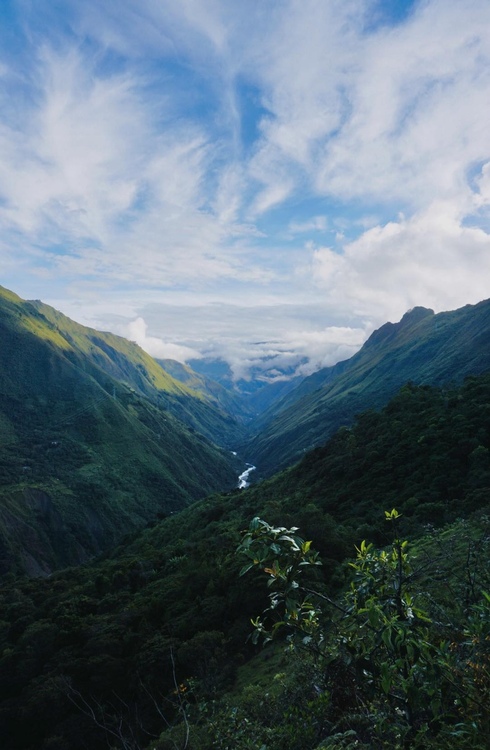
Two hours into the hike we stop at a small shelter (2,200m altitude) to catch our breath, and we can see the high point we’re aiming for. It feels just as out of reach as my breath. At 9am we make it to the top (2,850m).
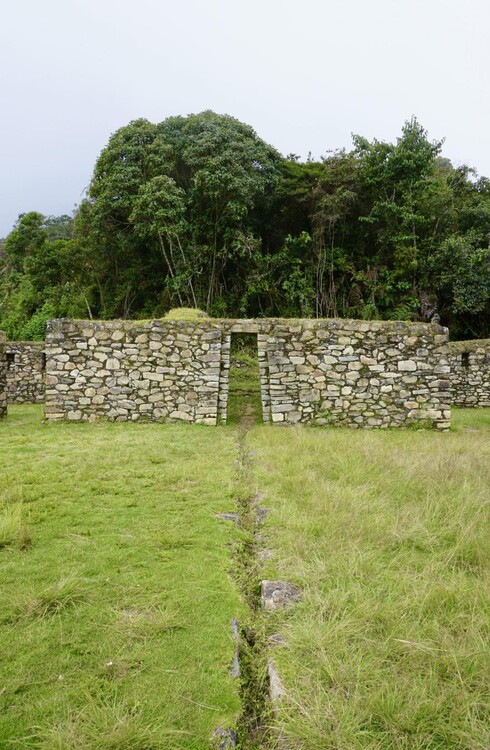
When we reach Llactapata we get a glimpse of Machu Picchu moments before the clouds swoop in and cover the ancient city. From Llactapata we can also see Huyana Picchu and terraces between the mountains. I’ve dreamed of visiting Machu Picchu since I was a young girl, so being so close brings a little tear to my eye. But, I quickly remember we have a long way to go.
Yuri tells us there are many Inca trails across South America, “A spider net of Inca trails 40,000km from Cusco to Chile, and Cusco to Quito existed.” There are many more ancient buildings than the Llactapata lookout that we’re standing at – this is the only unique building to be restored as it was the most important, he tells us.
“It was forbidden for farmers to go to Machu Picchu, which was only for the noble class.” I look around – we look like mere peasants in our hiking gear, dripping with sweat and smelling like we haven’t showered in days. I wonder if they’ll turn us away when we reach Machu Picchu tomorrow?
After a lesson on Llactapata we begin a gruelling descent.
At 11:30am we finally reach the bottom of the mountain where a freezing cold gushing river entices Mark to strip down and jump in.
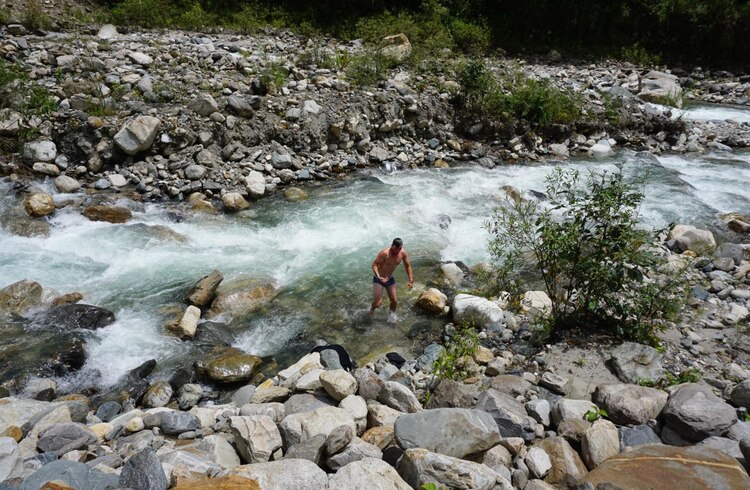
At 12:30pm we arrive at the very crowded and overwhelming Hidroeléctrica. After spending 4 days with just our small tour group, I instantly want to find somewhere quiet to hide from all of these people. I get the feeling Machu Picchu will be no different, and suck it up.
For lunch we eat soup, rice, potato curry, chicken and a plate of ice cream.
At 1:30pm we start the final 9.7km walk to Aguas Calientes. Trains pass us as we walk beside the tracks, and we’re constantly reminded to keep looking both ways in case we don’t hear the incredibly loud trains. We flop onto the bed when we arrive at our hotel around 4:30pm, but soon we get ready to go for dinner, or “the last supper” as Yuri calls it.
Day 5 – Machu Picchu
At 3:30am we wake to the sound of heavy rain. We don our wet weather gear (ponchos and all) and meet in the lobby at 4am, where we begin the 25 minute walk to the ticket point at the base of Machu Picchu. When we arrive at 4:30am there are already 50 or so other people standing in the rain for the 5am start.
We make it up to the gates of Machu Picchu by 6am after a very steep, difficult hike to the top. The steps are uneven and the trail is incredibly crowded. People are pushing their way past you, desperate to get there before the masses. Hundreds of people are lining up to get inside – it’s mayhem at the gates. At 6:30am the Machu Picchu tour begins.
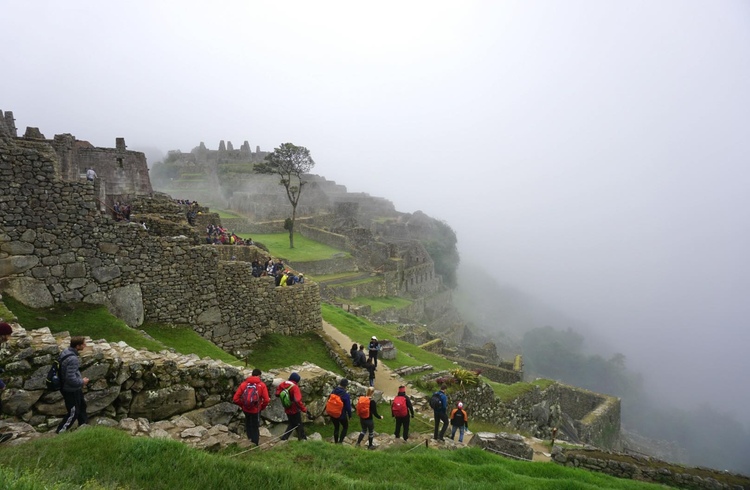
Yuri begins to enthusiastically tell us about the history of Machu Picchu as the fog surrounds us. “Machu Picchu was rediscovered in 1911. In 1915 the lost city was revealed to the world. The Kechuan people made a story about a civilisation in the jungle so that nobody would find Machu Picchu. Thanks to that story, Machu Picchu wasn’t destroyed. Machu Picchu was lost in translation because when the founder was asking the local people, they were saying ‘old mountain’. So, the lost city of the Incas got it’s name from a miscommunication. The original name was lost through time, the Incas didn’t use paper or keep documentation. Most of their information was kept secret – in codes.”
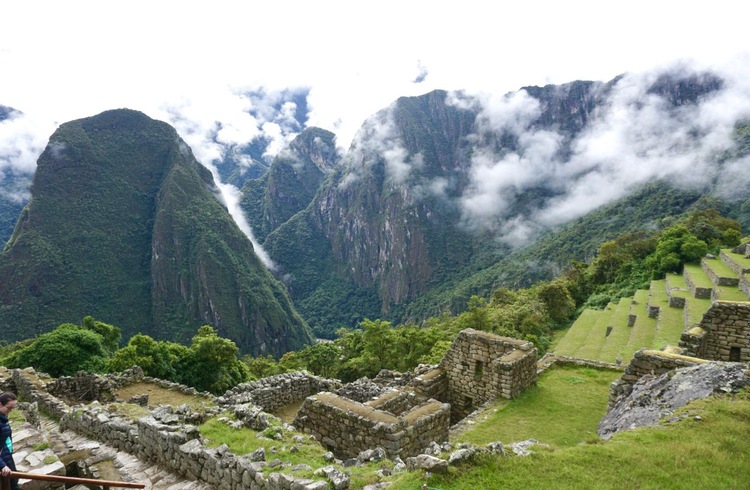
In 1912 archaeologists discovered 150 mummies, pots and many other objects during their excavations. A farmer from Mollepata was the first person to visit Machu Picchu as he was exchanging food from different regions. Over the years, history books have failed to mention a number of facts such as this one.
According to archaeologists, 400-500 people lived here, and they were wealthy – not from money, but knowledge.
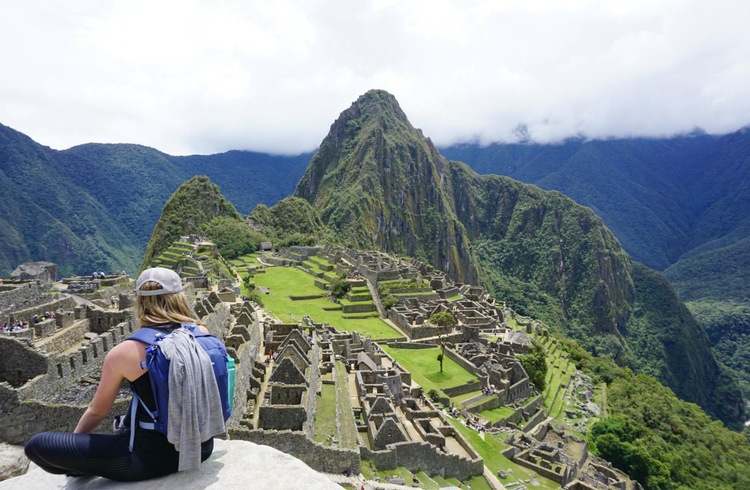
In 1533 people started to abandon the city when the Spanish were conquering Cusco. The people tried to destroy the Inca Trail too, and took all their important things.
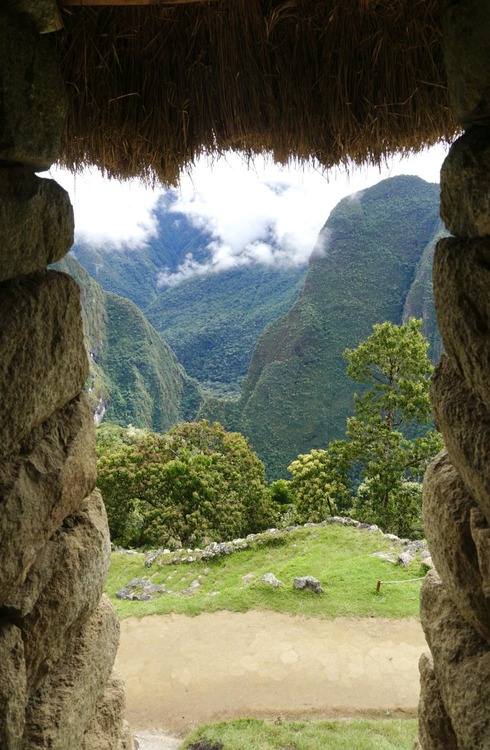
We start the hike to Huyana Picchu at 10am, and when we are 400m shy of the summit we decide to turn back. The views are beatiful from where we are, and we just can’t be bothered going any further.
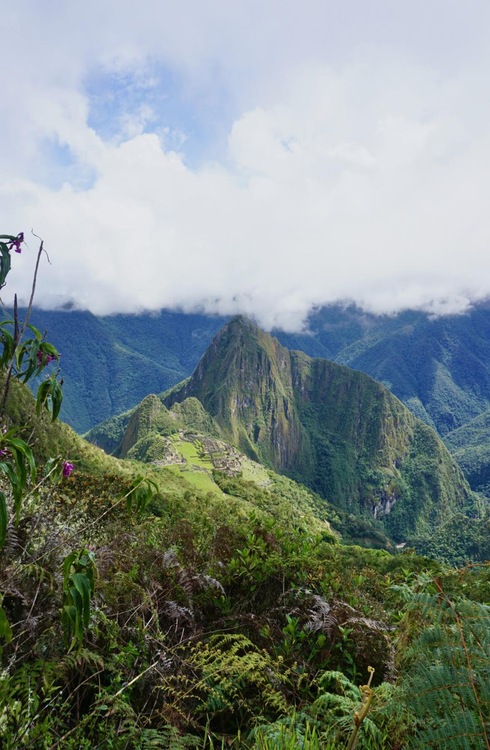
We hear the Sun gate and bridge are apparently good to see, but decide to leave that for another time – perhaps we’ll return one day with our daughter.
We leave Machu Picchu at 12:00pm and get to the bottom around 1pm. We head straight for the first pizza and beer restaurant we can find in Aguas Calientes and enjoy a meal. We’ve finished the Salkantay Trek.
Just after 4pm our tour group get on the train to Ollantaytambo, and our tickets include tea and two snacks. The views out the windows are sublime, and we’re all feeling pretty accomplished by the trek.
Would I do it again? For sure.
TL;CR (Too long, can’t read)
How long is the Salkantay Trek? Approximately 74km long
What do I need to pack for the Salkantay Trek? If you book with Salkantay Trekking (like we did), food is supplied along the way and accommodation is provided in sky domes, jungle domes and Andean huts. Each day you will carry a small pack with necessities (water, snacks, wet weather jackets/layers) and your larger backpacks and sleeping bags are carried by the horses and porters who leave ahead of you each day.
Here’s a basic packing list for the Salkantay Trek:
- Snacks
- Hiking pants/tights
- Hiking boots
- Extra pair of shoes (slides/thongs)
- Thermal layers
- Tracksuit pants
- 5 x underpants (one per day if you do the 5 day trek)
- Toiletries
- Hat
- Raincoat or poncho (this came in handy for us)
- Pair of shorts
- Head torch
- Extra money
- Personal medication
- Water bottle
- Insect repellant
- Sunscreen
- Trekking poles
- Camera
- Towel
- Swimmers
- Sunglasses
Is the Salkantay Trek hard? Yes, it’s rated moderate to difficult. It’s longer than the Inca Trail by approximately 30km (Inca Trail is 43km). However the bulk of your things are carried for you, meals are prepared by kitchen staff and the accommodation options are superb. Annapurna Base Camp and the W Trek are much more challenging.
What altitude does the Salkantay Trek reach? At Salkantay Pass you will reach 4,580m altitude, which is quite significant. You won’t spend much time at that altitude as you quickly descend after a photo opportunity. But you should expect to feel symptoms of altitude sickness, especially if you’ve never trekked at altitude before. Go slow and stay hydrated.
What is the food like on the Salkantay Trek? If you read the full story, you’ll get an overview on exactly what we are served each day. Expect banquets for breakfast lunch and tea.
Have you done the Salkantay Trek or the Inca Trail? Which was your favourite? Share your tips in the comments section.
February 23, 2024
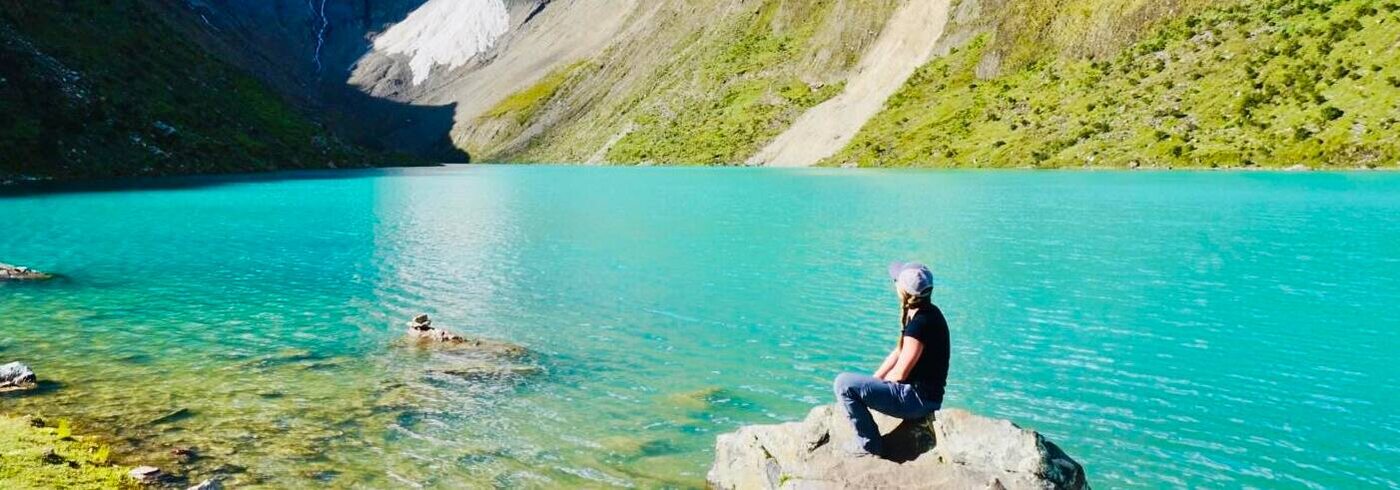
Join the discussion!